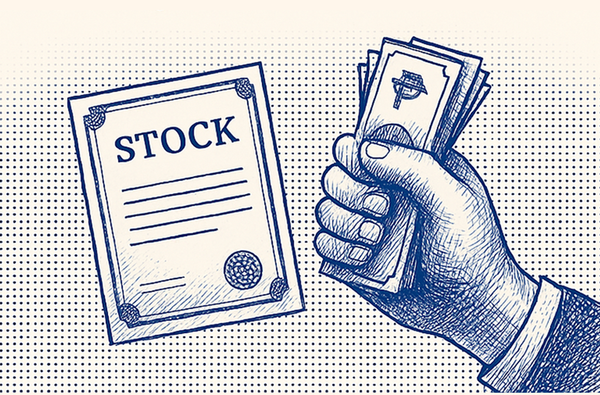What Makes Businesses Abnormally Profitable?

As recently as 2016, salt lamps were considered luxurious items with high price tags of 4 to 15 thousand pesos per lamp. My wife saw that salt lamps were sold incredibly cheap wholesale, so we started a business around them.
The Rise
We sourced salt lamps from wholesalers at a cost of 500 pesos each and sold them for 2,500 pesos - a 5x markup. Despite our high profits, we were cheaper than the others, which made us attractive to buyers.
Our pricing was so attractive that our business became one of the top 10 vendors on a prominent online marketplace at the time.
However, just like any other industry, our success attracted competition.
The Fall
As we were constantly exposed to "best sellers" lists, others took notice and started offering salt lamps at even lower prices. This forced us to follow suit, eroding our profit margins. Salt lamps had entered a price war.
The prices continued to drop. From selling prices of 2,500 pesos per lamp, we had to lower it to 1,500, then 1,000, then 750 per lamp.
At some point, the gap between the costs and the selling price of salt lamps became too small. The business wasn't worthwhile anymore, and the profits were not worth the efforts of managing these bulky, heavy lamps.
Despite our early success, we decided to stop putting effort into the salt lamp business.
How Competition Erodes Profitability
"Competition is for losers."
Peter Thiel
As I'm writing this, you can get a salt lamp from Lazada for 269 pesos - much lower than our initial wholesale sourcing price of 500 pesos per lamp.
Any businessman worth their salt (pun intended) has seen this pattern play out in their career. You start with a highly profitable venture. Then the competition senses this excessive profitability and enters, trying to take market share. Finally, the competition erodes profitability to regular or sub-par levels, and the weak are culled from the industry.
Peter Thiel is quoted saying that competition is for losers. In a competitive industry, profitability grinds down to a minimum (usually 8-10% return on equity) as firms lower their prices and invest in their capabilities, hoping to trade margins for market share. These efforts are ultimately futile because other firms are capable of making the same price cuts and investments.
After all that effort and investment, the industry ends up in the same competitive state: A bunch of firms doing the exact same things with zero differentiation.
An example is in order. Here's a quick timeline of 3 malls in the Philippines that I frequent: EDSA Shang, SM Megamall, and Power Plant Mall:
- In 2013, EDSA Shang opened its East Wing to add to the upscale selection of the mall. [1]
- In 2014, SM Megamall opened the Mega Fashion Hall, an upscale wing. [2]
- In 2017, Power Plant Mall opened a new upscale wing. [3]
The malls copied each other's tactics. Despite all of their investments, they were not able to differentiate themselves significantly and achieve abnormal profitability. As of 2023, all 3 firms had average returns on equity close to 10%.
Competition is the mechanism through which outsized profitability is lost.
How to Make Abnormally Large Profits
If everyone is competing for money -- cutting prices and forcing additional investments -- how can one possibly make an outsized return?
There are two answers to this: Competitive Advantages and Efficiency.
Method 1: Competitive Advantages or "Moats"
"I don't look to jump over 7-foot bars: I look around for 1-foot bars that I can step over."
Warren Buffett
Competitive advantages are systematic factors that defend businesses from competitors. Warren Buffett aptly calls them "moats" - a word normally used to describe deep ditches that protect castles from outside invaders.
Here are some examples of competitive advantages:
Network Effect
- Where a firm becomes more valuable with the size of its network.
- Examples: Viber, Meta, GCash.
- Customer point of view: "Why would I use your new chat app if all my friends are already on Viber?"
Switching Cost
- Where switching to a competing firm would be more difficult than usual.
- Examples: Adobe, AutoCAD, Apple.
- Customer point of view: "All my apps are already on my iOS account. Switching to Android would be a massive pain."
Brand
- Where a firm is already trusted for a habitual purchase, making customers prefer it over other competitors by default.
- Examples: Coca-cola, Starbucks.
- Customer point of view: "A new soft drink? No thanks. I'll get the usual -- a Coke Zero."
A quick aside: If you know any niche companies or products with competitive advantages in your industry (Some examples: car airbags, CPAP machines, and surgery robots), please let me know about them in the comments.
Businesses with competitive advantages can keep their revenues high without increasing their costs, giving them outsized profitability. Here are the 2022 returns on equity of some firms mentioned above:
- Meta: 18.6%
- Adobe: 33.86%
- Coca-cola: 37.45%
- Starbucks: 38.29%
Note that an average, competition-besieged business would usually make an 8-10% return on equity.
That's the first solution to competition: Avoid it. Be in a business that has less competition.
Method 2: Operational Efficiency
"Intensified competition will soon squeeze margins very significantly. But this is a development we welcome: Long term, a tough market helps the low-cost operator, which is what we are and intend to remain."
Warren Buffett
If you must compete for your profits, then you can still make outsized returns by being more efficient than other firms.
This is not an easy path to take. It requires long hours, hard work, and lots of penny-pinching. Like a professional sport, there can only be a handful of elites in operational efficiency. When playing this game, it is not enough to be great at what you do on an absolute basis. You must also outperform all the firms you are competing against.
Consider two coal producers:
- Firm A can mine 1 tonne of coal for $80
- Firm B can mine 1 tonne of coal for $100
If Firm B tries to wage a price war against Firm A, they will lose. In the event that the price of coal goes down to $100 per tonne, Firm B will be making no profits, while Firm A will still be grossing $20 per tonne.
It does not matter if Firm B’s founders did their best and sacrificed their lives for the company. If Firm A outperforms them, they simply cannot make an outsized return over the long run because Firm A will set the tone for the industry’s price structure.
A well-known example of an operationally excellent firm is GEICO, an insurance company Warren Buffett invested in.
The firm lowered its costs by focusing on selling motor insurance to government employees (who are known to be safe drivers) and by only using direct selling methods such as mail advertising.
These lowered their underwriting and claims costs, allowing them to offer cheaper prices to their customers. These cost-cutting measures allowed GEICO to achieve a return on equity of 30% in the 1980s - much higher than their peers.
That's the second solution to competition: Beat the competition.
Conclusion
"I refuse to join any club that would have me for a member."
Groucho Marx
My experience with the salt lamp business taught me that competition is an incredibly important part of the business that must be studied and respected.
The two ways to deal with competition are to sidestep it with Competitive Advantages and to deal with it head-on, becoming the best at Operational Efficiency.
Firms with Competitive Advantages have systemic structures that sustain their abnormally high profitability. When investing in such businesses, you can assume a brighter outlook compared to firms immersed in competition.
Firms without Competitive Advantages have to rely on being the best at Operational Efficiency to make outsized returns. When investing in competitive industries like airlines, mining, and retail, be careful. If the firm isn't great at Operational Efficiency, always assume that you're just one price war away from unprofitability.
Competition is the heart of business, and it can make or break a firm's profitability.
References
[2] https://business.inquirer.net/162009/h-megamall-now-phs-largest-mall
[3] https://www.manilastandard.net/business/178315/rockwell-land-buys-batangas-property.html
[4] Berkshire Hathaway's Letters to Shareholders
[5] Competition Demystified by Bruce Greenwald and Judd Kahn
[6] Understanding Michael Porter by Joan Magretta



